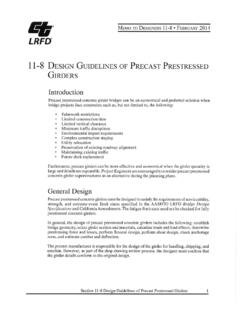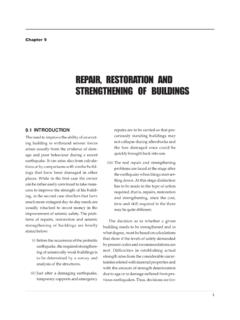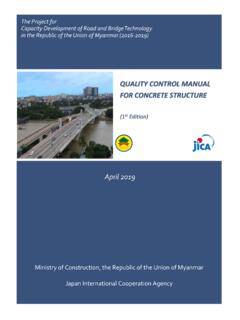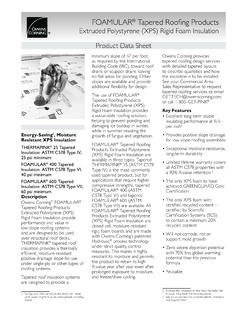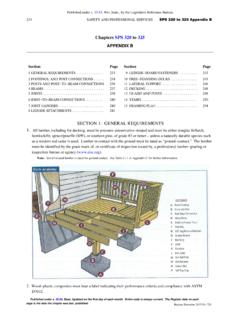Transcription of Soil Classification Outline
1 Soil Classification Outline different soil the methods of testing the the soil the weight of the case workers Rocki. Stable Rock is natural solid mineral matter that can be excavated withvertical sides and remain intact while exposed. It is usually identified by arock name such as granite or sandstone. Determining whether a deposit is ofthis type may be difficult unless it is known whether cracks exist and whetheror not the cracks run into or away from the A A Soils are cohesive soils with an unconfined compressive strength of per square foot (tsf) (144 kPa) or greater. Examples of Type A cohesivesoils are often: clay, silty clay, sandy clay, clay loam and, in some cases, siltyclay loam and sandy clay loam.
2 (No soil is Type A if it is fissured, is subject tovibration of any type, has previously been disturbed, is part of a sloped,layered system where the layers dip into the excavation on a slope of 4horizontal to 1 vertical (4H:1V) or greater, or has seeping B B Soils are cohesive soils with an unconfined compressive strengthgreater than tsf (48 kPa) but less than tsf (144 kPa). Examples of otherType B soils are: angular gravel; silt; silt loam; previously disturbed soilsunless otherwise classified as Type C; soils that meet the unconfinedcompressive strength or cementation requirements of Type A soils but arefissured or subject to vibration; dry unstable rock; and layered systemssloping into the trench at a slope less than 4H:1V (only if the material wouldbe classified as a Type B soil).)
3 C C Soils are cohesive soils with an unconfined compressive strength tsf (48 kPa) or less. Other Type C soils include granular soils such asgravel, sand and loamy sand, submerged soil, soil from which water is freelyseeping, and submerged rock that is not stable. Also included in thisclassification is material in a sloped, layered system where the layers dip intothe excavation or have a slope of four horizontal to one vertical (4H:1V) Geological Strata. Where soils are configured in layers, , where alayered geologic structure exists, the soil must be classified on the basis ofthe soil Classification of the weakest soil layer. Each layer may be classified individually if a more stable layer lies below a less stable layer, , where a Type C soil rests on top of stable rock.
4 Are direct-reading, spring-operated instruments used todetermine the unconfined compressive strength of saturated cohesive pushed into the soil, an indicator sleeve displays the instrument is calibrated in either tons per square foot (tsf) or kilogramsper square centimeter (kPa). However, Penetrometers have error rates in therange of 20-40%. determine the unconfined compressive strength of the soil with ashear vane, the blades of the vane are pressed into a level section ofundisturbed soil, and the torsional knob is slowly turned until soil direct instrument reading must be multiplied by 2 to provide results intons per square foot (tsf) or kilograms per square centimeter (kPa)
5 Thumb penetration procedure involves an attempt to press the thumbfirmly into the soil in the thumb makes an indentation in the soil only with great difficulty, thesoil is probably Type the thumb penetrates no further than the length of the thumb nail, it isprobably Type B the thumb penetrates the full length of the thumb, it is Type C soil. Thethumb test is subjective and is therefore the least accurate of the soil that crumbles freely or with moderate pressure into individual grainsis soil that falls into clumps that subsequently break into smaller clumps(and the smaller clumps can be broken only with difficulty) is probably clay incombination with gravel, sand, or the soil breaks into clumps that do not break into smaller clumps (and thesoil can be broken only with difficulty)
6 , the soil is considered unfissuredunless there is visual indication of or wet test is conducted by molding a moist sample of the soil into a ball andattempting to roll it into a thin thread approximately 1/8 inch (3 mm) indiameter (thick) by 2 inches (50 mm) in soil sample is held by one end. If the sample does not break or tear, thesoil is considered Visual i. A visual test is a qualitative evaluation of conditions around the site. In a visual test, the entire excavation site is observed, including the soil adjacent to the site and the soil being excavated. If the soil remains in clumps, it is cohesive; if it appears to be coarse-grained sand or gravel, it is considered granular.
7 The evaluator also checks for any signs of vibration. 1. During a visual test, the evaluator should check for crack-line openings along the failure zone that would indicate tension cracks, look for existing utilities that indicate that the soil has previously been disturbed, and observe the open side of the excavation for indications of layered geologic structuring. 2. The evaluator should also look for signs of bulging, boiling, or sluffing, as well as for signs of surface water seeping from the sides of the excavation or from the water table. If there is standing water in the cut, the evaluator should check for "quick" conditions. 3. In addition, the area adjacent to the excavation should be checked for signs of foundations or other intrusions into the failure zone, and the evaluator should check for surcharging and the spoil distance from the edge of the excavation.
8 4. Soil mechanics a. Tension cracks i. Tension crack usually form at a horizontal distance of to times the depth of the trench, measured from the top of the vertical face of the trench. b. Sliding or sluffing i. Sliding or sluffing may occur as a result of tension cracks. c. Toppling i. In addition to sliding, tension cracks can cause toppling. Toppling occurs when the trench's vertical face shears along the tension crack line and topples into the excavation. d. Subsidence or bulging i. An unsupported excavation can create an unbalanced stress in the soil, which, in turn, causes subsidence at the surface and bulging of the vertical face of the trench. If uncorrected, this condition can cause face failure and entrapment of workers in the trench.
9 E. Heaving or squeezing i. Bottom heaving or squeezing is caused by the downward pressure created by the weight of adjoining soil. This pressure causes a bulge in the bottom of the cut, as illustrated in the drawing above. Heaving and squeezing can occur even when shoring or shielding has been properly installed. f. Boiling i. Boiling is evidenced by an upward water flow into the bottom of the cut. A high water table is one of the causes of boiling. Boiling produces a "quick" condition in the bottom of the cut, and can occur even when shoring or trench boxes are used. Weight of Soils refers to the weight of one unit of a particular soil. Theweight of soil varies with type and moisture content.
10 One cubic foot of soilcan weigh from 110 pounds to 140 pounds or more, and one cubic meter ( feet) of soil can weigh more than 3,000 case 1, 29-year-old male Hispanic laborer with 5 years ofexperience died when the 2-foot-wide, 16-foot-long, and 9-foot-deepunprotected trench he was working in collapsed and covered him with soilduring waterproofing work. The victim and four other laborers, all of whomspoke primarily Spanish and very little English, had been hand digging thetrench over a 2-day period at a private residence. The victim was kneeling toinspect a broken drain pipe at the bottom of the east end of the trench. Thevictim s brother saw the soil strike the victim and knock his head against thehome s basement wall.










